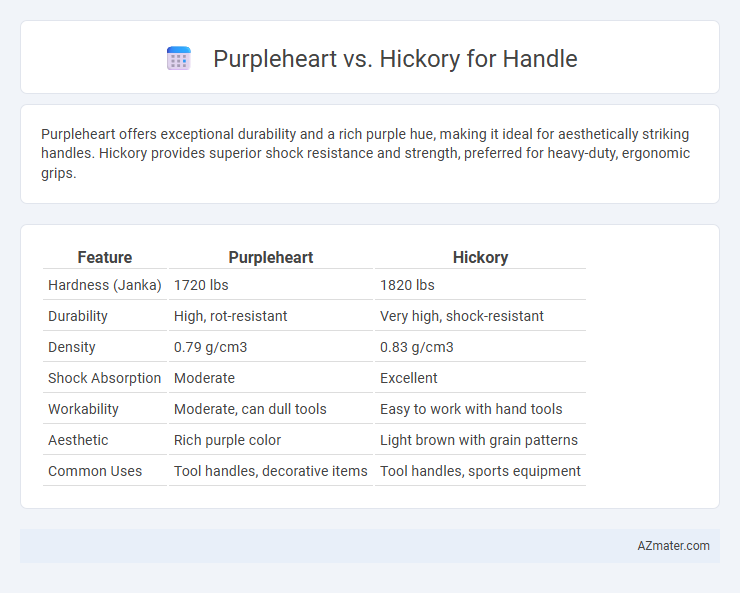Purpleheart offers exceptional durability and a rich purple hue, making it ideal for aesthetically striking handles. Hickory provides superior shock resistance and strength, preferred for heavy-duty, ergonomic grips.
Table of Comparison
| Feature | Purpleheart | Hickory |
|---|---|---|
| Hardness (Janka) | 1720 lbs | 1820 lbs |
| Durability | High, rot-resistant | Very high, shock-resistant |
| Density | 0.79 g/cm3 | 0.83 g/cm3 |
| Shock Absorption | Moderate | Excellent |
| Workability | Moderate, can dull tools | Easy to work with hand tools |
| Aesthetic | Rich purple color | Light brown with grain patterns |
| Common Uses | Tool handles, decorative items | Tool handles, sports equipment |
Introduction to Purpleheart and Hickory Handles
Purpleheart handles stand out for their vibrant purple hue and exceptional durability, making them a popular choice for tool and knife handles. Hickory handles are renowned for their toughness, shock resistance, and comfortable grip, often preferred in heavy-duty applications like hammers and axes. Both woods offer unique benefits, with Purpleheart prized for aesthetics and strength, while Hickory excels in resilience and impact absorption.
Wood Origins and Characteristics
Purpleheart wood, sourced primarily from Central and South American trees of the genus Peltogyne, is prized for its distinctive deep purple hue that intensifies with exposure to light. Hickory, native to North America, is known for its exceptional strength, shock resistance, and fine grain, making it a popular choice for durable tool handles. While Purpleheart offers unique aesthetics and hardness, Hickory excels in toughness and impact absorption, reflecting their different botanical origins and functional characteristics.
Strength and Durability Comparison
Purpleheart offers exceptional strength with a Janka hardness rating of approximately 2,520, making it extremely resistant to wear and impact for durable handles. Hickory, known for its toughness and shock resistance, has a Janka hardness around 1,820, providing solid durability but with slightly less hardness compared to Purpleheart. Both woods excel in strength, but Purpleheart's higher density and hardness deliver superior long-term resilience for handle applications.
Weight and Balance Considerations
Purpleheart handles offer a dense and heavier feel due to their high wood density, providing a solid and balanced grip ideal for tools requiring more control. Hickory handles are lighter with a natural shock-absorbing quality, resulting in a well-balanced tool that reduces user fatigue during prolonged use. Choosing between Purpleheart and Hickory depends on the desired weight distribution and handling comfort for specific task requirements.
Shock Absorption Abilities
Purpleheart offers moderate shock absorption, providing a balance of hardness and slight flexibility, which helps reduce vibrations in tool handles. Hickory excels in shock absorption due to its natural elasticity and fiber structure, effectively minimizing hand fatigue during prolonged use. For handles prioritized on impact resistance and comfort, Hickory is generally preferred over Purpleheart.
Aesthetics: Color and Grain Patterns
Purpleheart exhibits a rich, vibrant purple hue that deepens with exposure to light, providing a unique and eye-catching handle appearance. Hickory offers a more traditional look with creamy to light brown tones and distinctive, pronounced grain patterns that convey strength and durability. Both woods present striking aesthetics, but Purpleheart stands out for bold color while Hickory appeals through classic, rugged grain textures.
Workability and Shaping
Purpleheart offers moderate workability with good resistance to wear, requiring sharp tools and careful handling during shaping due to its density. Hickory is easier to shape and machine, known for its excellent workability, toughness, and shock resistance, making it ideal for handles with intricate designs. Both woods provide durability, but Hickory allows faster and smoother shaping with less tool wear compared to the harder, more fibrous Purpleheart.
Resistance to Elements and Wear
Purpleheart offers exceptional resistance to moisture, decay, and wear, making it highly durable for handles exposed to harsh environmental conditions. Hickory is known for its superior impact resistance and toughness, but it is less naturally resistant to water and requires sealing for prolonged outdoor use. Choosing between the two depends on the balance between Purpleheart's natural resistance to elements and Hickory's superior shock absorption and wear under mechanical stress.
Maintenance and Longevity
Purpleheart handles require minimal maintenance due to their natural resistance to decay and insects, offering long-lasting durability with occasional oiling to preserve their rich color. Hickory handles demand more frequent care, including regular oiling and inspection for cracks, to maintain their strength and flexibility over time. Both woods provide excellent longevity, but Purpleheart's dense and stable properties make it less prone to wear and environmental damage compared to Hickory.
Best Applications and Final Recommendation
Purpleheart offers exceptional durability and natural vibration resistance, making it ideal for tool handles and sports equipment where impact absorption is crucial. Hickory provides superior shock resistance and flexibility, perfect for axes, hammers, and handles requiring toughness under heavy, repeated use. For applications demanding long-lasting strength with moderate shock absorption, purpleheart is recommended, while hickory excels in tools needing maximum shock resistance and resilience.

Infographic: Purpleheart vs Hickory for Handle
 azmater.com
azmater.com